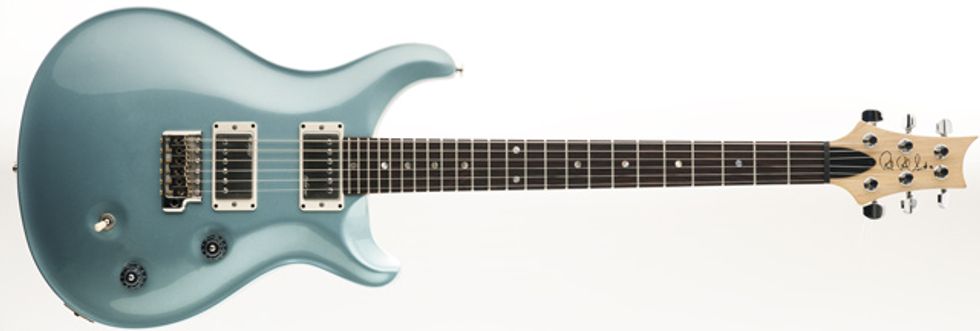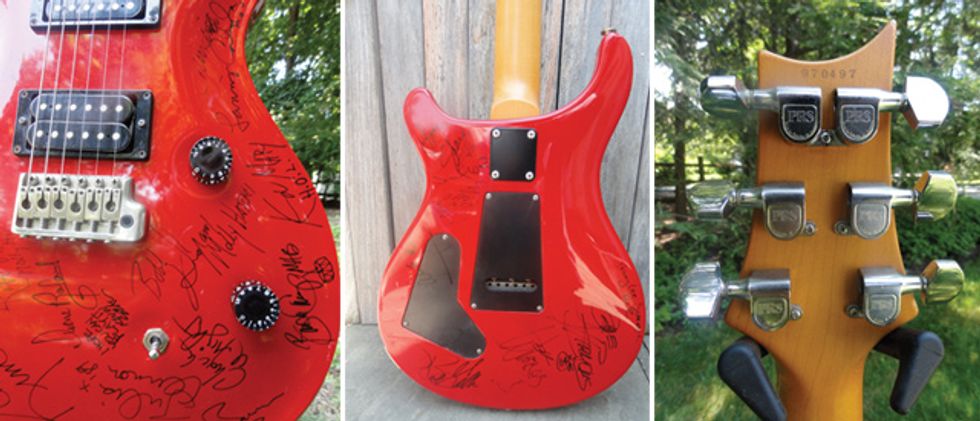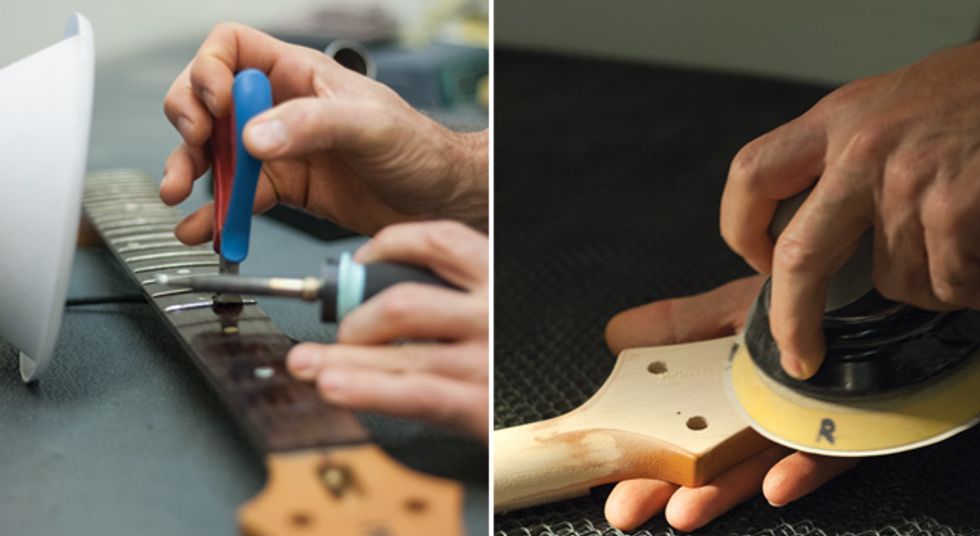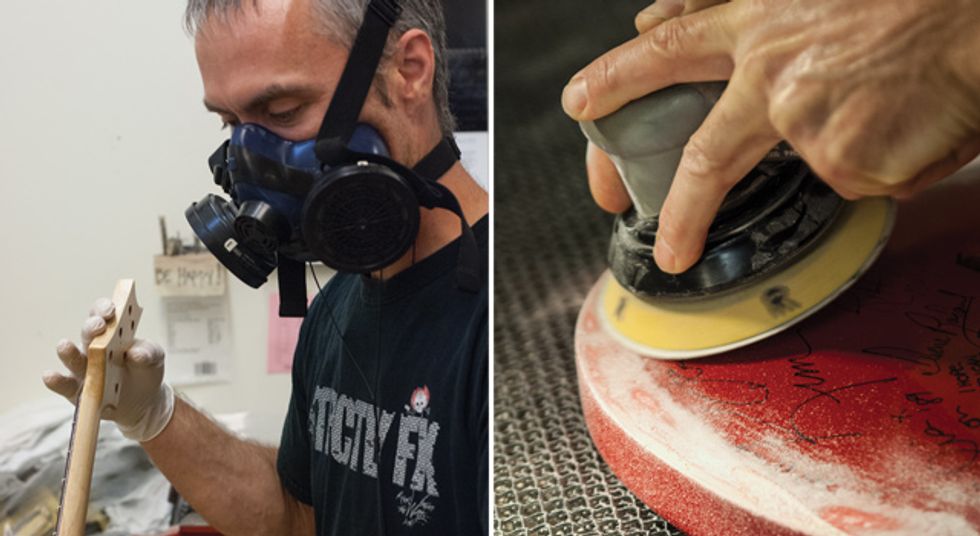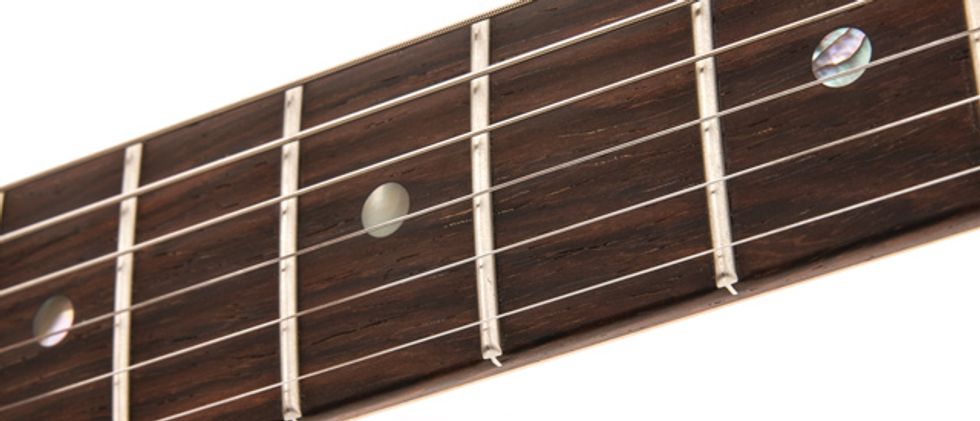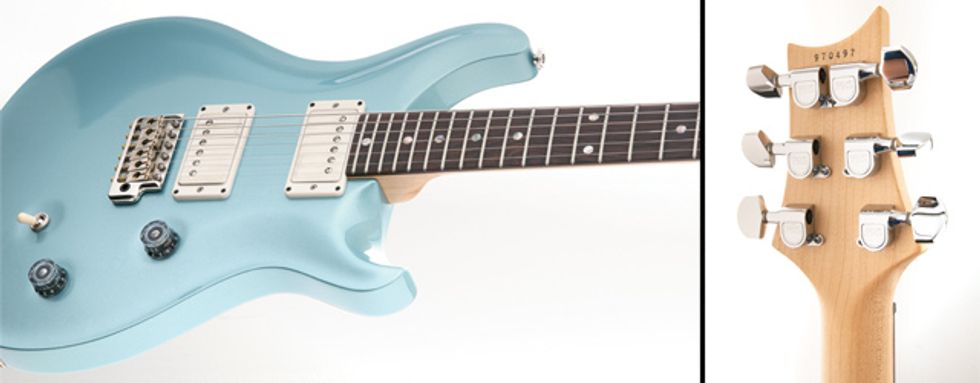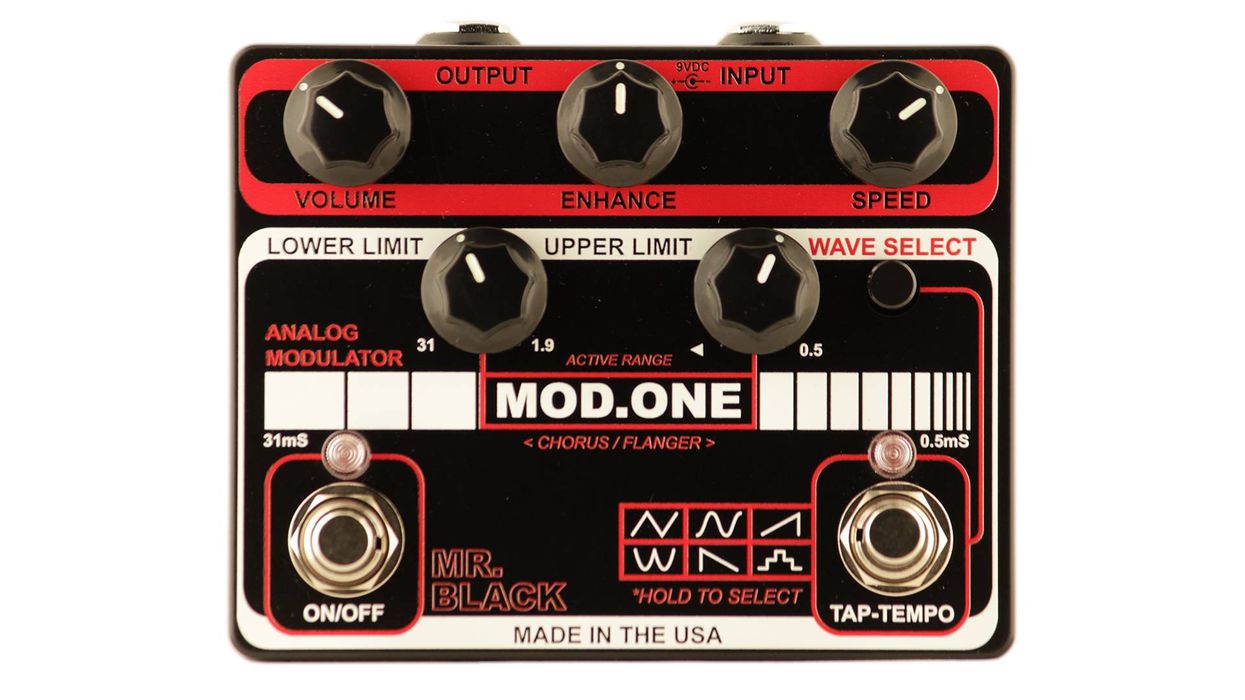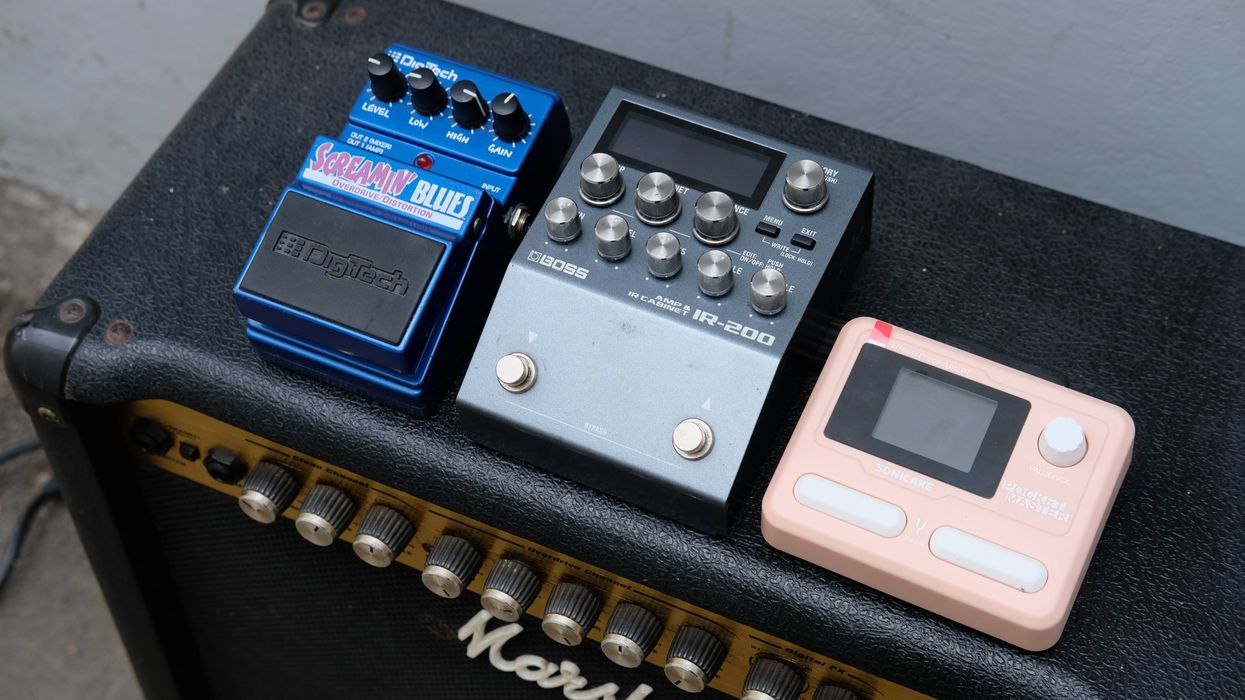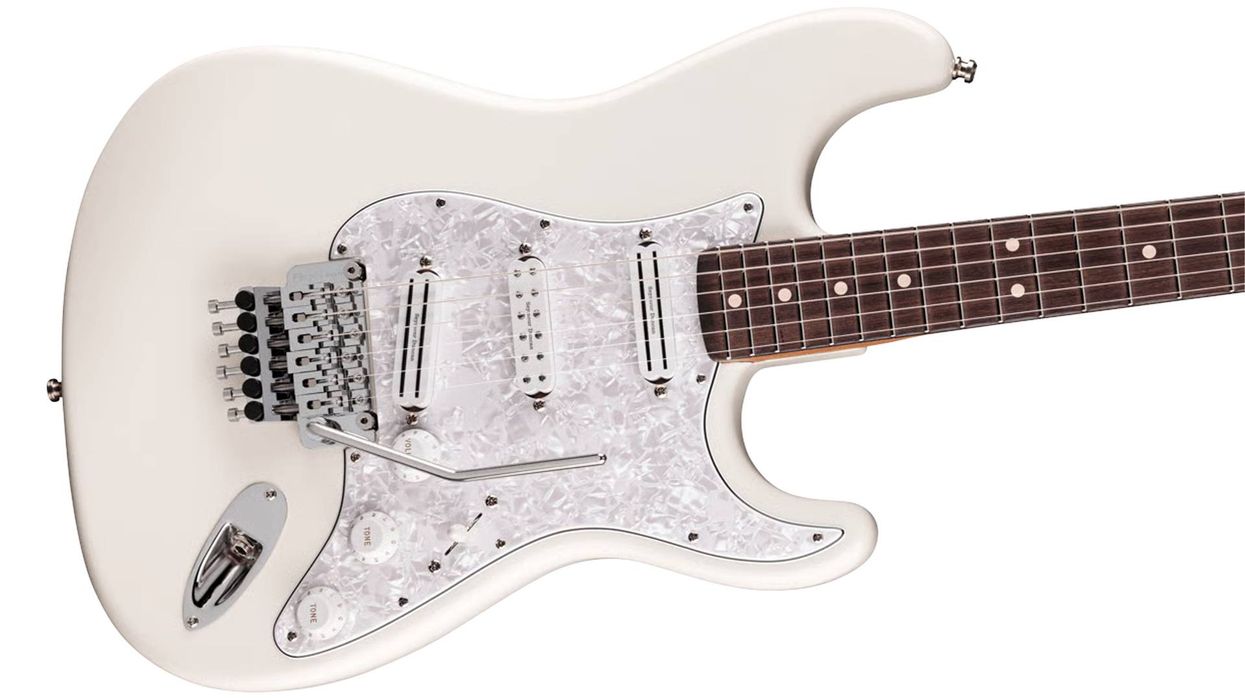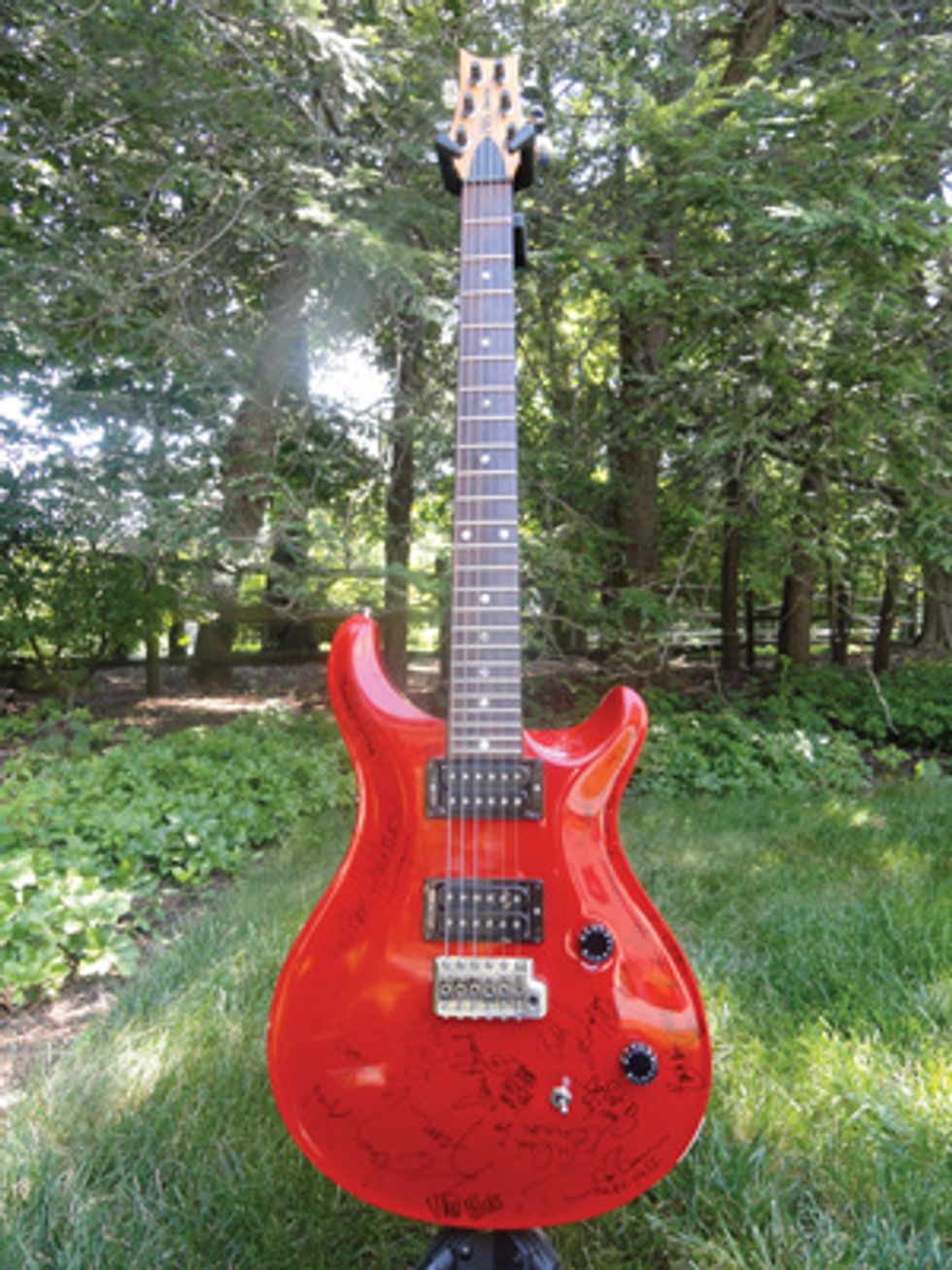
The PRS was originally outfitted with Standard Treble and Standard Bass pickups, and a 1-piece MannMade brass bridge.
About four years ago, a good friend of mine—a collector of art and firearms—called to ask if I’d ever heard of a “Pairs” guitar. From time to time, this friend reaches out if he runs across a guitar in one of the many obscure auction sites he frequents. Naturally, I was puzzled. As a lifelong guitar enthusiast, how could I have missed these rare—and apparently valuable—Pairs guitars?
To help me understand what he was talking about, he directed me to an auction website where, amongst lots of old furniture and artwork, there was a listing for a “PRS Guitar (autographed).”
After breathing a sigh of relief that there wasn’t some obscurely amazing brand of guitars I’d somehow been oblivious to all these years, I had to chuckle at my friend’s innocence.
But wait—it gets funnier.
I clicked the link and up popped a series of pictures of a beat-up 1989 PRS CE as bright and gaudy as Thomas Magnum’s Ferrari—only after it’d been tagged by a bunch of Sharpie-wielding ’80s artists, including Julian Lennon, the Vixen vixens, the guys from House of Lords, Henry Lee Summer, and the ax-wielders of Molly Hatchet. Needless to say, the more affordable bolt-on model bedecked with celebrity autographs of yesteryear wasn’t quite a rare find of the sort dreamt about by your average guitar collector. But under the scribbles and blinding red finish I could still see that there was a (hopefully) nice vintage PRS guitar looking for a new home.
The CE after the “off the
frame” customization.
I’ve always appreciated older PRSes, because they remind me of my early guitar-playing days, when PRS hit the scene with its innovative, Gibson-meets- Fender hybrid design. Nostalgia factor notwithstanding, I also had a soft spot for older PRS instruments. Though I didn’t think of them as better or worse than current models, the fact that they’re from a very different period of the company’s history—way before it became the third-biggest player in the industry—intrigued me. And when no one placed the $750 minimum bid, how could I say no when I called and was offered the guitar for $600?
The Hour of Reckoning
When the guitar finally arrived,
it was both better and worse
than I had expected: Most of
the time, getting the original
case with a 24-year-old guitar
is pretty cool. But opening the
CE’s unleashed a stench indicating
that, at some point, it
had been used as a cat’s litter
box. On top of that, the guitar
had seen better days—the frets
and nut were worn down, the
tremolo was out of balance and
missing its arm, the finish was
worn off in spots, and the body
had a bunch of dings and dents,
probably from a bunch of Less
Than Zero-type moments back
in the day.
On the plus side, it was all-original. It still had the coveted Standard Treble Standard Bass humbuckers. It still had the 1-piece MannMade tremolo bridge. It still had Phase I “winged” tuners with the D- and G-string units that share a mounting screw. And it still had the 24-fret, Indian-rosewood-topped maple neck with the shorter neck heel. Typical of well-played guitars, it had a wonderful, broken-in feel and a balanced, snappy acoustic tone, thanks to its aged alder body. Despite needing some TLC, the guitar was very resonant and comfortable to play, weighing in at 7 pounds, 6 ounces. Plugged in, the guitar sounded really nice, too, though signal-cutout and grounding issues made it clear the electronics needed some help.
Having assessed the pros and cons of my new find, I faced a big dilemma: Should I stay grounded in PRS history and keep the guitar in its original condition or keep the best of the old and upgrade the stuff that could be better? Certain PRS enthusiasts would say this early CE represents the company’s “golden era” and that changing its original components would amount to blasphemy. Others take the position that PRS has pretty much only gotten better over the years and that current-production guitars incorporate decades of innovation and refinement.
Truth be told, I hadn’t kept up with the company’s major design and hardware changes over the last 10 years. I’ve always tended to believe that most well-established manufacturers’ truly groundbreaking ideas came out with the initial designs of flagship models. In my somewhat jaded view, subsequent “innovations” are more often than not spawned in the name of cost cutting or creating marketing buzzwords. Either way, such measures don’t usually improve the tone or playability of an instrument. I’m sure I’m not the only one who thinks this way, either.
I did some research to help me with my decision and found the folks at PRS formally established the PRS Technical Center (PTC) in 2009 at the Stevensville, Maryland, factory to expand the capabilities of the in-house team tasked with providing warranty-fulfillment services. I reached out to Shawn Nuthall, who’s been with PRS for 11 years and is manager of the PTC, to learn more about the center. According to him, the PTC was formed at the direction of Paul Smith and in response to demand from PRS owners who wanted custom work. Staffed by a committed, seasoned team of five PRS employees whose average tenure with the company is 12 years, the PTC still provides owners of PRS guitars with warranty work, but it also fields requests for repairs, custom work, and restorations. The PTC also offers retrofits of older PRS guitars with the latest hardware and design updates found on current-production guitars. Shawn shared his position that current PRS guitars reflect the “golden era” for the company and that I should consider having the PTC team undertake a full “off the frame” restoration of my ’89 CE—a bold proposition to prove out a bold claim.
LEFT: The autographs from members of Vixen, Molly Hatchet, and other ’80s bands ... MIDDLE: ... even spilled over to the rear of the CE. RIGHT: The guitar also came with its original PRS Phase I “winged tuners.”
I was intrigued. Could there really be some sort of guitar alchemy going on here, or was it merely marketing hype? There was only one way to find out. I packed the guitar into its original litter-box case and sent it to Stevensville with mixed emotions and an air freshener.
When my Magnum P.I. PRS arrived at the company’s current home, the PTC team assessed it and then, over the phone, Shawn walked me through what the job would entail. Off the frame restoration is exactly what it sounds like: It calls for taking the guitar down to bare wood and rebuilding it with current production components and techniques, along with a few proprietary artist tweaks. The only original components that would remain would be the wood, tuner housings, neck plate, and single-action truss rod. In deference to the ’80s artists who had autographed the guitar, we discussed the pros and cons of refinishing it but decided it needed a full-on makeover. All the PTC team needed was my approval, my selection of current-production PRS pickups and finish, and three weeks to work on it. I gave a hesitant “yes,” gave them my finish and pickup preferences, and waited.
Stripping, Buffing,
and Refinishing
As the before and after pictures
here show, the PTC team’s work
reflects both their expertise and
their commitment to perfection.
The first step was stripping the
guitar of the nitro finish on the
neck and removing the acrylic
finish from the 3-piece alder
body. Indentations in the body
and neck were then sanded out,
the frets were removed, and the
Indian rosewood fingerboard
was re-profiled. The neck was
then refretted with medium jumbo
standard nickel-silver
fretwire made specifically for
PRS. (It’s similar in size to 6150
Dunlop fretwire.) The original
Delrin nut was replaced with
PRS’ current composite nut,
which was designed and perfected
through a series of trial
and error to maximize sustain
and tuning stability.
LEFT: A PRS Technical Center luthier removes the worn original frets. RIGHT: The back of the headstock gets its finish removed.
PRS finishes have apparently evolved over the years, as well. Current methods call for maple necks to receive a proprietary finish that seals the wood from the inside out, resulting in a very natural, bare-wood feel that does not get “gummy” like nitro can after long periods of playing. The body received the company’s new V12 hybrid finish, which purportedly retains the hardness of acrylic and the dipped-in-glass look PRS guitars are known for. However, like nitro, it’s very thin, which allows the guitar to breathe and resonate. I was told that there has been a continued emphasis on reducing the thickness of the finish over the years and that V12 is actually thinner than the base coat used on PRS guitars like mine from the ’80s. Given that my guitar has a 3-piece body, the PTC team recommended I get an opaque finish. I chose frost blue metallic, a welcome update to the PRS color palette that has a subtle glow.
LEFT: PRS is meticulous about instrument and worker safety. RIGHT: Sadly, the signatures had to come off for the greater good.
Hardware Upgrades
The Schaller-manufactured
original locking tuners were
truly innovative in the ’80s, but
obviously the guitar-building
universe has learned a lot since
then. PTC rebuilt my Phase I
tuners using components from
current-production PRS Phase
II and III tuners, including
mass-reducing hollow buttons,
grommets that are countersunk
into the headstock, unplated
brass tuner shafts (PRS has
determined that removing plating
from hardware that has
contact with the strings results
in clearer, more open tones),
and string-release mechanisms
that are much easier to use
than the original wing design.
Current PRS tuners feature
an open-back housing (which
the company says is purely
cosmetic) with a smaller footprint
than the original Phase
I tuners. Among other things,
this eliminates the need for the
shared mounting screw for the
D- and G-string units. In lieu
of putting extra holes in my
guitar, the folks at PTC rebuilt
the tuners on my guitar, putting
the guts of current machines
into the Phase I housings.
My CE’s original MannMade USA Vibrato, which PRS used from 1985 until the early 1990s, is highly regarded by many PRS enthusiasts. The unit was constructed from a 1-piece brass casting with either nickel or gold plating, and it won many fans quickly with its smooth action and tuning stability. Unfortunately, over time and with heavy use, the knife edge begins to dig in and tuning stability begins to suffer. My guitar apparently saw its fair share of whammy dive-bombs over the years, so I decided to replace the MannMade unit with the current-production tremolo, which comprises a milled-brass bridge and plate screwed together. The bridge unit is still nickel plated, but the plating has been removed from the parts of the bridge saddles that come into contact with the strings because PRS says that bare brass offers more favorable tonal characteristics than plated brass. The brass saddle-height and intonation screws are unplated for the same reason. These tweaks are representative of PRS’ commitment to refining an established design for the sake of tonal improvement, not cost cutting.
Changing pickups was by far the most trying decision for me, because the original Standard Treble and Standard Bass units sounded great and are coveted by many PRS aficionados. To my ears, they definitely had a vintage vibe, with a touch more compression and output than other vintage pickups I’ve used over the years. The extra compression was particularly nice when paired with a good overdriven tube amp. Back in the ’80s, they were Paul Smith’s best interpretation of a classic humbucking alnico pickup, and they were known for their upper-midrange response and pronounced bite.
The final fretwork is exemplary—they’re perfectly seated and the ends are immaculately dressed.
But there’s a saying at PRS that goes something like this, “There are three levels of hearing: What humans hear, what dogs hear, and what Paul Reed Smith hears.” Since the early ’90s, Smith and his team have been challenging themselves to create the ultimate vintage-PAF-style humbucker. These R&D efforts were augmented in 1994, when PRS brought in veteran Gibson executive Ted McCarty as a consultant to offer insights on the guitar designs and pickups of golden-era Gibson electrics from the late 1950s and early ’60s. Combined with input from big-name artists and the same sorts of materials used to manufacture original Gibson PAF humbuckers, these insights led to a series of vintage-style PRS pickups, culminating in 2008 with the 57/08 humbucker—which Paul Smith feels is the best PAF-style humbucker. Since then, PRS has also added models such as the 59/09 and 53/10, which offer slightly different tonal responses.
Even PRS knobs and wiring have been improved over the past 23 years. My CE’s original black speed knobs were replaced with the company’s current 11-sided, tapered “lampshade” knobs, which are easier to manipulate and aesthetically in keeping with the guitar’s new color scheme. Likewise, the original, industrial-sized chrome pickup selector switch and black pickup covers were also replaced with crème current-production parts that complement the overall aesthetics. The guitar was completely rewired, and the PTC crew even provided a pleasant little surprise by augmenting the original 3-way switch with a push-pull coil-splitting function on the tone knob, which provides three additional sounds I really like.
The Other Hour of
Reckoning
As of press time, I’ve had my
CE back for a month and I’m
very pleased with the results—there’s a substantial improvement
in tone, playability, and
aesthetics. My only regrets are
losing the character and signatures
of yesteryear. When I got
the guitar, it had a great broken-in
feel and it just reeked a late-
’80s vibe that brought back a lot
of memories. I can’t complain
about that loss of character too
much, though, because the PTC
gave my CE a vast improvement
in all aspects. The re-fret and
leveling of the fretboard took
away some of that broken-in
feel—but hey, it’s my turn to
break it in. The neck feels amazing,
too—the finish is natural
feeling and plays fast. The guitar
just rings like a bell.
It would be challenging to identify exactly what yielded such significant improvements to the tonal response and playability—I’m not sure if it’s the finish, the pickups, the exposed-brass string-contact points, or just the whole package together—but I’ll share some thoughts.
First off, although changing pickups was the most difficult decision, it’s the one I’ve been the happiest with. The original pickups were cool in a band setting—they were hotter and more compressed than the 57/08s, and they cut through well—although they weren’t as appealing when playing unaccompanied. In the past, some players have been critical of PRS pickups because they felt they were lifeless and/or too hot. Personally, I wasn’t crazy about the pickups in a McCarty I owned. But the 57/08s change all that in my book. To my ears, they’re warmer than the originals, but just as capable of cutting through a band mix while also maintaining a pleasing, balanced tone that’s a lot of fun when you’re playing by yourself. They have amazing clarity, they’re very dynamic when you adjust the volume knob, they have the right amount of high-end bite that you expect from an authentic-sounding PAF-style pickup, and they’re equally surefooted with clean or overdriven tones—I noticed a big difference in string-to-string definition. And the natural overtones are plentiful and glorious.
The split tones are useable, albeit not very Fender-ish—which is often what players are going for when they decide to split coils. They also come with the usual volume drop, and the tone knob’s tapered shape takes additional effort to pull out—although I’m sure I’ll become more adept at it over time. The new PRS 408 pickup system does the split-tones-and-stable-volume thing more convincingly, but the 57/08s are some of the best vintage-sounding humbuckers I’ve encountered in a long time—and I’ve had my share of great-sounding Lindy Fralin, Gibson, Wolfetone, Suhr, Peter Florance Voodoo, Seymour Duncan, and DiMarzio pickups.
LEFT: The completed guitar features new PRS 57/08 pickups, exposed-brass
string-contact points, and tapered knobs. RIGHT: The tuners now feature modern PRS parts
in the original Phase I housings.
My experience with the new bridge tells me that the 1- vs. 2-piece trem debate will likely continue for hardcore PRS fans. All I can say is that, to me, the new 2-piece unit is very stable and neutral sounding—it’s set up perfectly, with just a touch of float, it stays in tune with slight trem moves and dive-bombs alike, and it does not rob the guitar of any sustain.
I hate to gush, but after a long hiatus, I am squarely back on the PRS bandwagon. In my opinion, Paul Reed Smith and his team remain as committed to innovation and improvements to their offerings as they were 25+ years ago. I want to extend a special thanks to the PTC team—Shawn Nuthall, Scott Bloomfield, Dave Meredith, Len Johnson, and James Zimmers—for a job well done. Oh, and to any of you guys who signed this thing way back when—you’re welcome to come autograph it again!
